When you go about finishing your embroidery projects into something-or-other – whether it’s into a Christmas ornament (that’s what I’m doing lately), a needlebook, an elaborate box, or myriad other things – you’re going to need a few helpful tools.
I have one favorite tool that I could not live without during the finishing stages of any embroidery. But when it comes to making ornaments, this simple tool – rather ubiquitous in any sewing or needlework-related craft room – has to meet certain criteria.
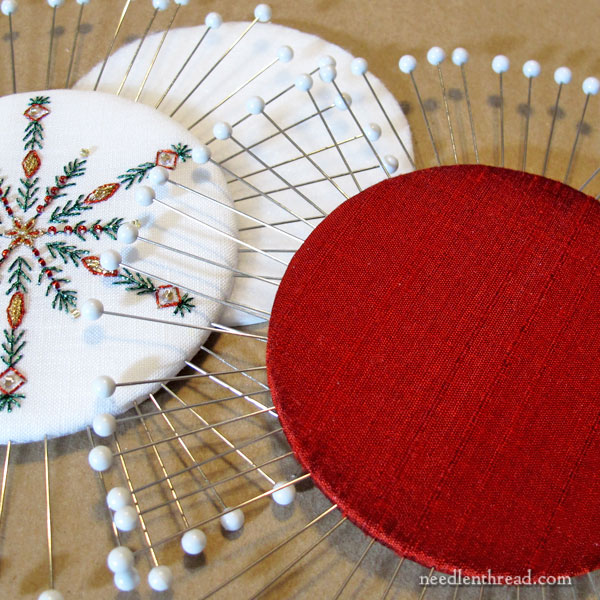
By now, you may have figured out what tool I’m talking about.
It’s in the photo above. And it’s pretty common!
But before you think I’m a bit nuts writing about something so obvious and so common, give me a moment to explain. If you’re interested in finishing your embroidery into things, you may find this helpful!
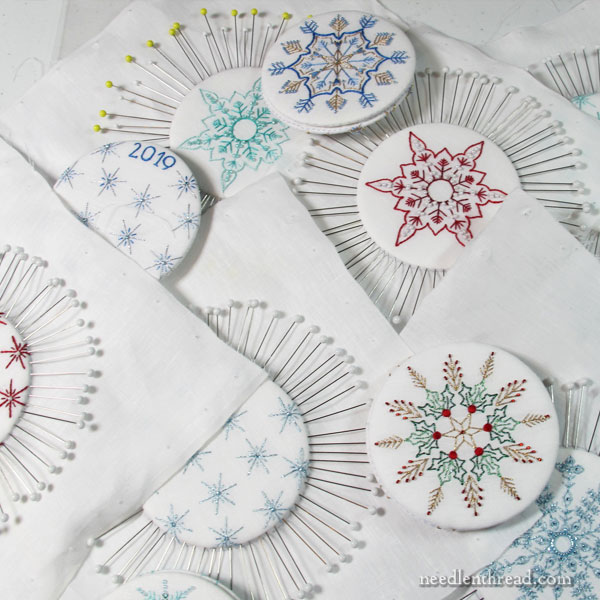
Ok, I’ll just get to the point…!
The tool is the pin.
Pins are common in any sewing room. Most people who indulge in needle arts have at least a few in a pincushion somewhere – if not a box or ten floating around.
When it comes to finishing things like ornaments, though, you want your pins to have certain characteristics.
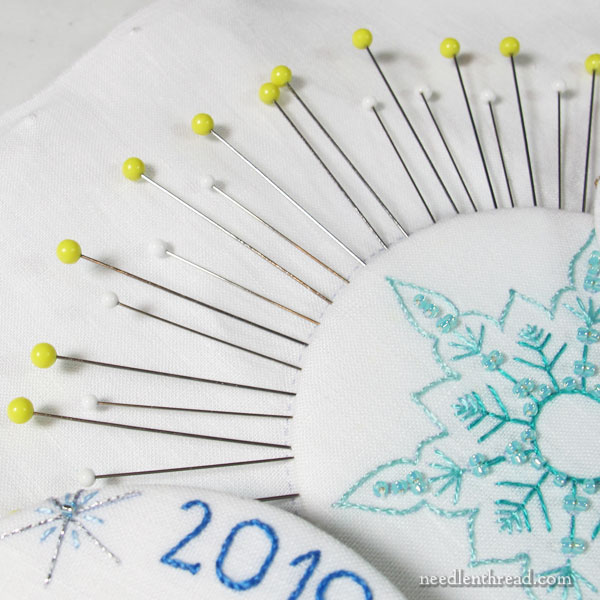
Obviously, pins should be sharp. Sharp pins pierce things much more easily! They should be free of burrs and similar flaws. You don’t want them snagging or pulling your fabric as they are pushed through it.
While very fine, very flexible pins are useful for some sewing applications, when you’re doing finishing work, the pins you use need to be strong. They can have some flexibility in the Bendy Category, but they shouldn’t be super flexible.
You have to push those pins into sometimes-very-tough foundation materials, and if you’re working with very fine, bendable pins, the job will take longer and you’ll definitely feel the frustration.
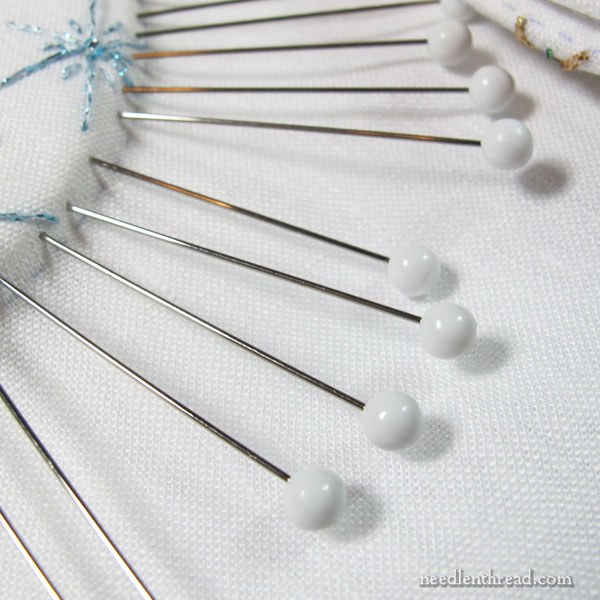
I like pins that have some length to them, too. Why? Because I often use them to pick up and hold onto the thing that I’m working on.
I usually go for 1.5″ long pins, but I’ll use 1.75″, too.
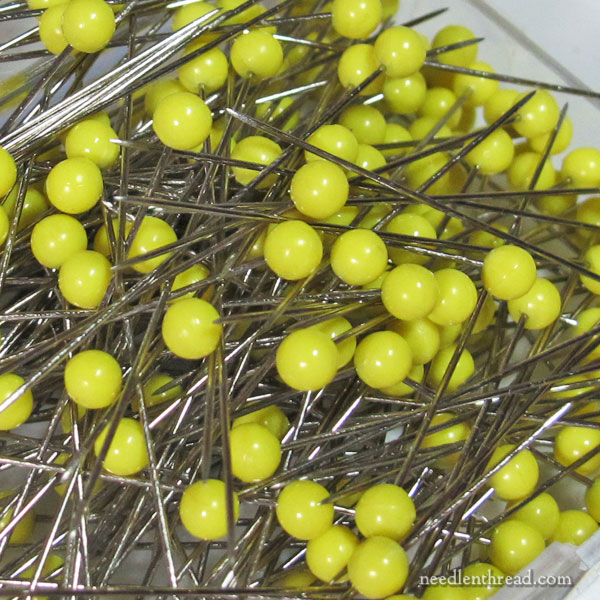
Finally, this is no place for the little steel pins with tiny flat heads.
No siree, Bob! If you want your fingers to remain functional and you want to avoid unnecessary pain and aggravation, look for pins that have the biggest, fattest glass or plastic round heads on them that you can find.
Pins with large heads are easier to push in and pull out because they give you something substantial to hold onto.
Finally, you want a lot of pins at your fingertips. Look for pins that come in a decent quantity per package.
Whenever I am getting ready to go into a bout of finishing, I make sure I have at least a couple boxes of quilting needles on hand.
They don’t have to be the most expensive pins out there. They should be good enough quality that the tip is sharp and the shaft is sturdy and reliable. They should have a nice, plump heads that stays on the shaft (nothing more annoying that heads that pop off!). And they should come in a box of many.
Mostly, I use Annie’s Choice IBC quilting pins. They come in boxes of 250 (I can easily empty one or more boxes in a bout finishing, so I have several boxes).
They are relatively fine stainless steel pins (.60mm), but strong, and while somewhat flexible, they’re not prone to bending much when they’re pushed into hard materials. They have sharp tips and big old heads. I buy the 1.5″ and the 1.75″ length – whatever’s easily available when I need pins. I prefer the 1.5″ (they have white heads), but I’ll use the yellow 1.75″ when I can’t find the white ones.
In a Nutshell
If you want to make your life easier when finishing embroidery into things, get decent pins that meet these criteria:
1. They are sharp and smooth (no burrs!).
2. They are strong and not too flexible.
3. They have some length to them. No place for petit pins! 1.5″ long are good.
4. They have large glass or plastic (round) heads. The larger the better!
5. They come in large quantities. 20 pins won’t do it when you’re doing finish work – you want more like 200 or more.
Little Treasures
I marvel at the fact that 400 years ago, pins were an expensive and treasured commodity!
Today, we tend to take pins for granted. I’ve seen folks throw away pins, simply because they had too many and were sick of storing them!
But every time I use a pin, I think of it as a little treasure. They’re such an incredibly simple tool – but where would we be in any sewing or needlework endeavor, if we didn’t have them?
They’re marvelous little wonders!
On that note, for your weekend entertainment, here’s a little poem about pins by Horace Elisha Scudder, from The Bodleys Telling Stories (mid-late 1800’s).
Children! What becomes of the pins
That are put in the cushion each day?
They vanished away before evening comes,
Or you are half-tired of play.I will tell you a secret revealed to me
As I lay dreaming one night,
By a queer little sprite who perched on my ear
And showed me a curios sight.Invisible elves who watch for pins
In each corner and crevice hide;
They seize those that fall with joy and delight,
And mount on the pins astride.They ride till they come to Fairy Land,
Where elves are waiting to take
The pins that are lost and crooked and bent,
And wonderful changes they make!They turn them to minims and musical notes,
Giving to each a sound;
Then away the elves fly to your music books,
Where melodies sweet are found.Do you see the little black heads in a row
Where your music lesson begins?
Before they were carried to Fairy Land,
The notes were rows of pins!The elves have secured them behind the bars
Arranged for piano or harp;
The broken and bent are now made flat;
The other pins still remain sharp!
So now you know where all your missing pins go.
Enjoy your weekend!







Dear Mary
I love my pins what would we do without them, they are a necessary part of our embroidery projects that we don’t even think about them we just use them for various projects and just accept them as part of our daily usage, but what would we do without them. I really like your snowflakes ornaments they are lovely and beautifully embroidered. I must remember to buy the pins you have suggested, like you I like pins with large round plastic or glass heads. Thanks for sharing with us your thoughts on pins and how important they are, I love the poem, now I know what happens to all those pins I have lost, ha, ha. I hope you have a great pinful weekend and enjoy whatever you are involved in.
Regards Anita Simmance
Lovely post and poem! I am wondering if you have a link showing how you are finishing those pieces? In particular, what is the foundation material you are using.
Hi, Valerie – All that information is going to be included in the e-book on the snowflakes. It should be out in about two weeks! 🙂
What a great article. I’ve learned some lessons about pins the hard way. Same story with needles. I bought a packet of “beading needles” once. LOL I spent more time poking myself than the beads. Talk about flexible. The poem about needles is terrific. Wish there was a story book with artwork. I’d buy it for my grandkids and one for me. 🙂
Morning Mary ~ Ah the lowly pin, comes in all sizes from short sequin; medium length and fine shaft silk, bought a box to make daughter’s wedding dress 25 years ago, have never used them again but love the memories they bring; to long corsage, still have mine from high school dances 50 years ago.
The quilting pins are the best though, as you say, so versatile in so many applications, and you can never have enough, wonderful for craft construction to hold things in place for a bit. Some are kept in various pin cushions for projects but most are in a nice big decorative tin. They hold paper notes up on my design wall. They help mark a starting point in my cross stitch after counting threads with the corsage pins, just slip it through the weave and easily find your place on the back. And guess what, they can be gently hammered into the wall to hang a lightweight photo frame or hoop finished embroidery, and should you decide to move a piece the hole made is barely visible. Glass headed pins are my favorite, no chance of melting if they get near a hot iron.
I went to a holiday bizarre on Saturday and saw a simple, yet fabulous idea. The vendor used a very small mason jar, I think it was a one cup jelly jar.. They made a pin cushion on top of the lid, glued the band to the lid, and put the pins inside the jar. Brilliant. Perfect way to store all those straight pins. I’m making one this weekend
Any brand of pins in particular that fit all of your criterion? What’s really piqued my interest is the photo of how you’re finishing those snowflakes. Will you walk us through that process?? It looks really cool and I’d really like to know more! 🙂
Hi, Denise – Yes, that will all be included in the e-book that goes with the snowflake collection! Yay! I like Annie’s pins – just because those are the ones I first bought that fit all the criteria. I found them at a local quilt store. I’m pretty sure you can find them online.
Love the poem!
I agree – I like big pins, bright and colorful pins and I like LOTS of pins. well said….
Love that pin poem ! 🙂
Mary, that little poem is so sweet! I LOVE pins; I have so many different kinds for all the different types of sewing/quilting/embroidery that I do. One of my favorite finds (was it through your site in the past?) was insect pins for appliqueing wool. Those buggers are sharp, but I have one pin book dedicated to them for wool applique. And I love my half-size little Japanese glass-head pins for fabric applique. I also love the faux pearl-headed pins for big jobs and for tacking inspiration to my design wall. I have a set of blue-headed (solid) pins that I can’t find anywhere now, so I treasure those. They are so thin that if I forget to pull them out and the machine needle goes over them, they’ve never broken or bent (though I always try to get them out first, I sometimes miss a few). A week doesn’t go by that I don’t think about pins and how much I depend on them, so I especially enjoyed this post on the humble pin. Also, I love your pin keeper “circles”: what a great idea (do they have a name?)! Those would make wonderful Christmas stocking gifts (and doable in an evening for those of us who work during the day). Thanks for sharing; it’s always a joy to read your practical and inspiring thoughts and techniques!
G’day Mary,
Great subject and advice. I always buy glass head pins as use them for dressmaking etc too and the iron disfigures plastic heads, if not eats them altogether! Wouldn’t be so bad if the pin kill wasn’t left on the iron!
Love the poem.
Cheers, Kath
I usually do, too, but when it comes to saving my fingertips when doing finish work, I like the biggest head I can get on a pin, and usually, those are plastic. :-/ Isn’t the poem cute? I’ve wanted to share it on here for a while, but I never had the appropriate article to share it in! LOL!
Mary, can you tell me what type of fabric the red is? it is beautiful. Thank you Love your snowflakes.
Silk dupioni. ☺️
“Pin money” may be the term for a ladies pocket change, but the pins themselves are certainly not ‘non-essentials’! I like the glass headed pins for everyday use and the very fine ‘silk pins’ for applique.
I’ve made circular pin keeps to go with a couple of sets of ‘needlework smalls’ where you leave the pins pushed into the edges of the circle to make a decorative edge by themselves.
I love pin keeps! They’re practical ornaments all on their own! 🙂
Please if you can place those lovely pins on your Amazon page. It makes life easier to locate things that actually work. You are so talented.
Sigh – a Google search for “Annie’s pins” turns up your article as second but no luck on finding on-line UK sources. Sniff, sniff …
Regards,
Helen
Did you ever try corsage pins?